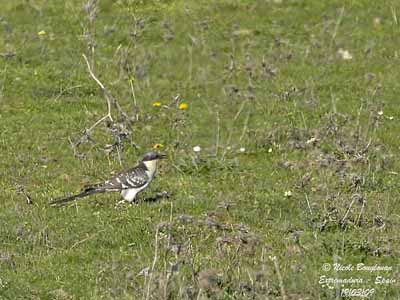
PROTECTION / THREATS / STATUS:
The Great Spotted Cuckoo is usually uncommon in most parts of its range, but becoming conspicuous in the areas where it does occur.
According to the range, the species expands its range such as in S Europe and Middle-East, or decreases in numbers as in Egypt.
The Great Spotted Cuckoo also disappeared as a breeder bird from NW Africa.
However, the species is not threatened at this moment.
Fr: Coucou geai
All : Häherkuckuck
Esp: Críalo Europeo
Ital: Cuculo dal ciuffo
Nd: Kuifkoekoek
Sd: Skatgök
Port: Cuco-rabilongo
Photographers :
José Luis Beamonte
Pájaros de España
Callie de Wet
Flickr Galleries
Nicole Bouglouan
PHOTOGRAPHIC RAMBLE
Text by Nicole Bouglouan
Sources :
HANDBOOK OF THE BIRDS OF THE WORLD vol 4 by Josep del Hoyo-Andrew Elliott-Jordi Sargatal - Lynx Edicions - ISBN: 8487334229
THE HANDBOOK OF BIRD IDENTIFICATION FOR EUROPE AND THE WESTERN PALEARCTIC by Mark Beaman, Steve Madge - C.Helm - ISBN: 0713639601
L’ENCYCLOPEDIE MONDIALE DES OISEAUX - Dr Christopher M. Perrins - BORDAS - ISBN: 2040185607
ENCYCLOPEDIE DES OISEAUX DE FRANCE ET D’EUROPE – de Peter Hayman et Rob Hume - Flammarion – ISBN : 2082009920
Pájaros de España (JL Beamonte)
SORA Searchable Ornithological Research Archive (Blair O. Wolf)
Great Spotted Cuckoo
Clamator glandarius
Cuculiforme Order – Cuculidae Family
BIOMETRICS:
Length: 35-39 cm
Wingspan: 58-60 cm
Weight: 124 g
DESCRIPTION:
The Great Spotted Cuckoo is a famous brood-parasitic species, laying the eggs especially in Corvids’ nests.
Adult has brown upperparts with conspicuous white feather tips. On the wings, the flight feathers are greyish with white tips. The long tail of about 14-18 cm is graduated and tipped-white too.
Underparts are white, except the pale buff throat. Thighs are well feathered and white.
Head shows blackish face and nape. The grey crown shows a slight grey crest. The bill is slightly down-curved and black. Eyes are brown surrounded by grey eye-ring. Legs and feet are blackish.

Both sexes are similar.
The juvenile has black head (face and crown). The flight feathers are rufous and the underparts rather pale buff than white.
After the first moult, the flight feathers show both rufous and grey-brown colours. The eye-ring may be reddish or grey.
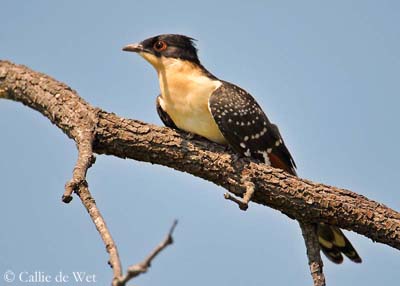
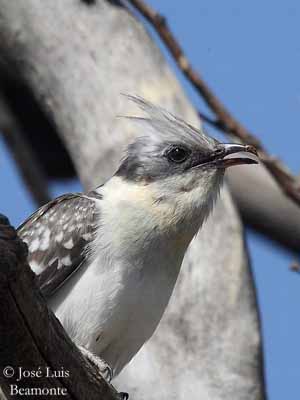
VOICE:
The Great Spotted Cuckoo’s typical call is a croaking sound, often given from a concealed perch. The advertising call by the male is a regularly repeated “kleeok”. We can also hear a trilled “kirrrr”.
During the flight displays, it utters loud, rasping “gah-gah-gah…gak-gak-gak…ko-ko-ko”, falling in pitch but increasing in tempo.
The female’s typical call is a rolling “gi-gi-gi-gi…ku-ku-ku-ku”.
HABITAT:
The Great Spotted Cuckoo frequents semi-arid habitats such as open woodlands (mainly acacia thorn-scrub), rocky hillsides in dry savannahs and dry cultivated areas with bushes and trees. It can be often seen flying over open areas.
According to the range, and especially in Europe, it can be found in heathland, often with cork-oaks or Pinus pinea. It also frequents thickets and olive groves.
This species occurs between 500 and 2000 metres of elevation.
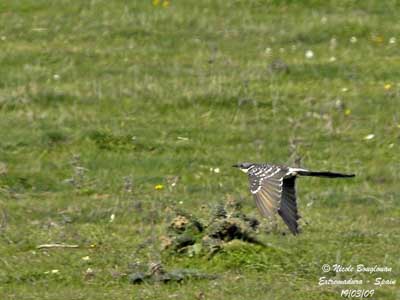
RANGE:
The Great Spotted Cuckoo breeds in SW Europe and Asia Minor, and also in Africa.
All populations winter in Africa, from North Africa and south of the Sahara to Central Africa.
Small numbers are regular in Spain during winter.
BEHAVIOUR:
The Great Spotted Cuckoo feeds on insects, and primarily on large hairy caterpillars of which it removes the hairs before to swallow them. It also catches termites, grasshoppers, moths and also takes small lizards.
It feeds mainly on the ground by walking, running and hopping, searching for prey in the grass and from the vegetation, pecking insects and caterpillars and walking again.
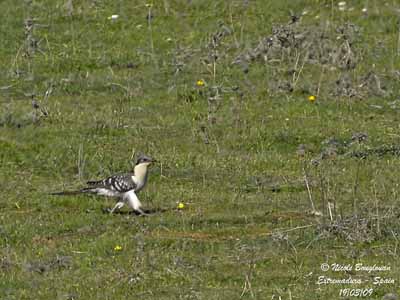
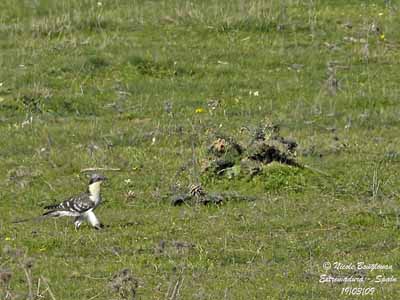
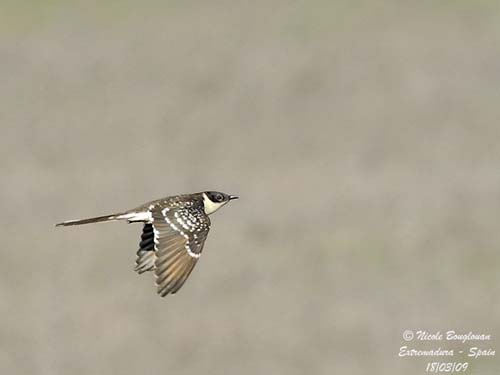
When mating, the male often presents a caterpillar to the female after attracting her by calling.
During the sexual displays, the long tail is often raised and spread in order to expose the bold black and white tail pattern.
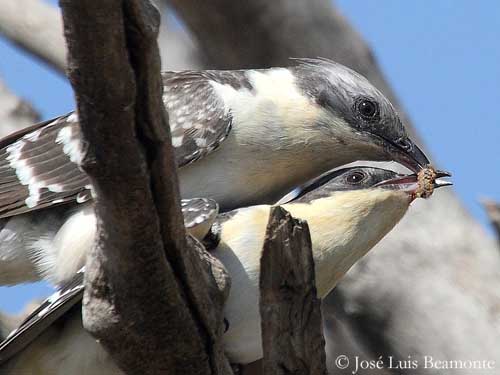
Then, the pair defends a territory where several magpies’ nests are present.
The Great Spotted Cuckoo breeding in Europe migrates to Africa for wintering, although small numbers winter in Southern Spain.
The West African birds seem to be only local migrants, with probably some resident in Senegal. Local movements in Africa are closely associated to rains and aridity.
FLIGHT:
The Great Spotted Cuckoo performs fast, undulating and laboured flight during which the long tail is conspicuous.
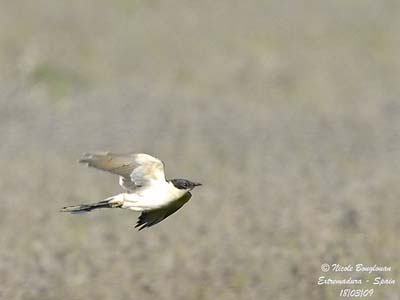
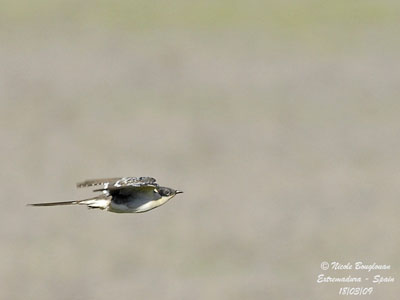
REPRODUCTION:
The Great Spotted Cuckoo does not build any nest, and often parasitizes Corvids’ nests and especially those of crows, ravens and magpies, and sometimes starlings’ holes.
At the beginning of the breeding season, it searches for magpies building their nests.
Both mates work together and often, while the male tries to disturb and attracts the magpies away from its nest, the female lays her eggs in the abandoned nest. This type of competition lasts during the whole breeding season.
The female cuckoo may damage the host eggs by laying hers on top of the brood. Sometimes, the magpies remove the cuckoo eggs whereas crows do not. Eggs of both species are almost similar in colour, slightly paler and smaller for those of the Great Spotted Cuckoo.
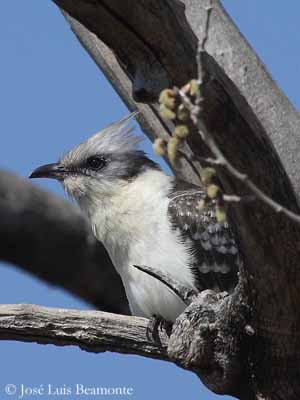
The female lays between 12 and 25 eggs per season. They are pale greenish or bluish with dark markings. She may lays more than one egg in the host nest, and sometimes, there are several cuckoo eggs in the Corvid nest.
Incubation of cuckoo eggs lasts about 12-15 days, shorter than host eggs.
The chicks are naked with yellow or pink skin at hatching. They do not evict the host eggs. One week later, they have reached 50% of the fledging weight and beg food with almost the same call that the young corvids.
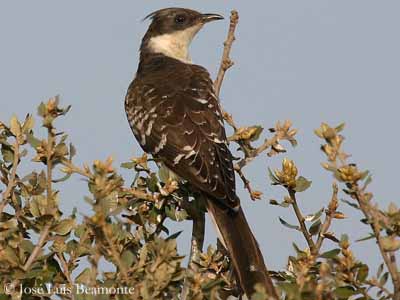
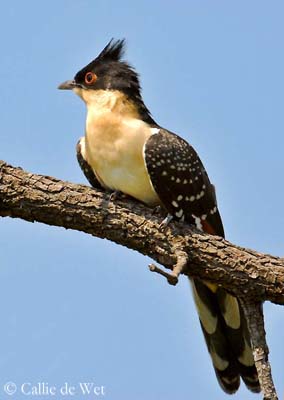
The young cuckoos fledge between 19 and 26 days after hatching. Their foster parents feed them for about three weeks more. They form social groups where several adult magpies rear them.
As the cuckoos hatch before the magpies, they receive much more food from the adults. When the magpies hatch, they are much smaller and often die by starvation.
The adult cuckoos may damage the host eggs by pecking, involving the death of the eggs which are removed by parents magpies, giving more chances to the young cuckoos to survive.
DIET:
The Great Spotted Cuckoo feeds primarily on hairy caterpillars from which it removes the most parts of the hairs before to swallow them. It often feeds on the ground where it searches for preys by walking, running and hopping. It also catches insects such as grasshoppers, termites, moths, and also small lizards.
